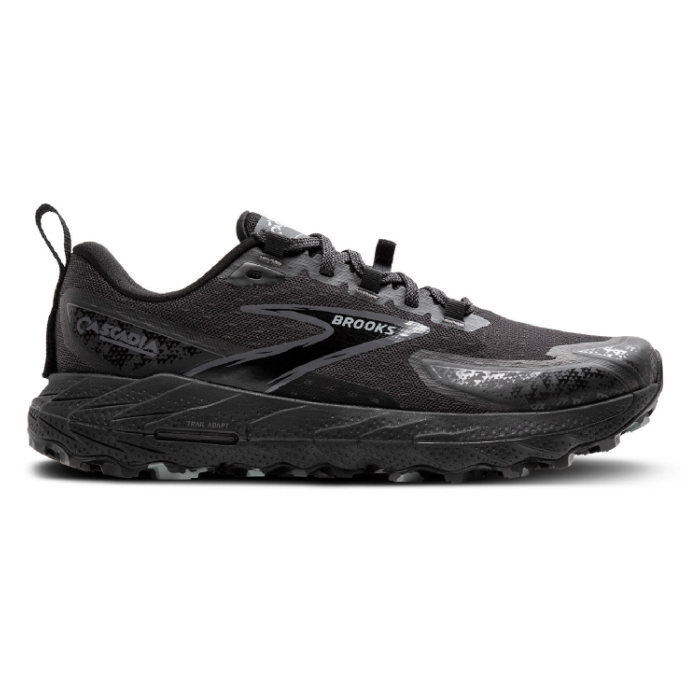
Men’s Brooks Cascadia 18 Review
Bottom Line
The Brooks Cascadia 18s are versatile, comfortable, and breathable and some of our favorite men’s hiking shoes built for long miles on established trails. These shoes are one of our favorites at CleverHiker: we’ve logged over 6,000 miles on America’s most scenic trails in these shoes, including the PCT, CDT, the Pinhoti Trail, and sections of the Colorado Trail. Weighing only 11 ounces per shoe, they balance sturdiness and agility well thanks to solid traction and springy foam midsoles that make it a breeze to tackle various terrains.
However, the Cascadias are less durable than other hiking shoes, especially on rough routes, since the thin upper mesh can develop holes after 400 miles. With a heel-to-toe drop of 8mm, they offer excellent cushioning, but at the expense of ground feel. If you’re looking for lightweight footwear for a summer of trail runs, day hikes, and long-distance backpacking, these are a great choice.
Quick Specs

Men’s Brooks Cascadia 18
Supportive & Comfortable Trail Runners for Long Distances
Score:
82.3/100
Price:
$140
Weight (Pair):
1 lb. 7.3 oz.
Heel-to-Toe Drop:
8 mm
Pros
- Cushioned heel and midsole
- Versatile for road and trail running
- Large heel tab
- Flexible uppers
- Less expensive
Cons
- Laces get stiff over time
- Mesh uppers blow out
- Less ground feel than other trail runners
Comfort
The Brooks Cascadia 18s are comfortable out of the box and require almost no break-in time. Their snug fit and simple, effective lacing system is a winning combination that makes these one of our favorites for long days. The Cascadias feel secure all day with no need to re-tie your laces every few hours. These shoes stand out for their excellent lateral stability, making them feel agile and solid on most terrain and obstacles.
We’re also big fans of their breathable mesh uppers that keep your feet cool and dry, which is especially noticeable during intense activity and hot weather. Their flexible uppers allow for natural foot flexion, and the foam midsoles create plush cushioning whether you’re running fast downhill on pavement or backpacking slowly uphill.
The Cascadias have a few downsides when it comes to comfort, though. This version of the Cascadias has a rigid internal plastic liner under its soft ankle cuff that can rub against ankles over time, leading to potential pain and irritation on longer outings. And the thin tongue doesn’t provide much cushioning, which we really feel on the top of the foot after 15+ mile days.
The laces, while effective initially, tend to stiffen over about a hundred miles, and can be a bit cumbersome to thread and tie. And, the 8 mm heel-to-toe drop is on the high end when it comes to support, which might not suit everyone’s biomechanics or needs.
Traction
The Brooks Cascadia 18s have decent traction thanks to their sticky rubber outsoles and knobby multidirectional lugs. This tread pattern grips surfaces well during ascents thanks to their triangular tread at the toe and forefoot and provides reliable braking at the heel on descents, making the Cascadias feel especially stable on trails with lots of ups and downs. The Cascadia 18s traction makes them ideal for tackling a variety of trail conditions for maintaining a steady pace and keeping excellent control.
Although the thick foam midsoles provide great comfort, this amount of foam reduces your overall ground feel and diminishes the sensory feedback needed to adjust your stride and find perfect foot placement on technical routes. The lugs on these shoes are also a bit shallow, limiting how effective they are on slick rocks, steep dirt trails, and wet surfaces where deeper traction matters. We also found that the tread durability is not as robust as other trail running shoes, so you may want to avoid rugged terrain or you’ll risk quicker wear and have less effective grip over time.
Weight
The Brooks Cascadia 18s are some of the lightest hiking shoes we’ve tested, weighing in at just one pound, six ounces for the pair. Thanks to their mesh woven uppers, thin TPU overlays, and lightweight foam midsoles, the Cascadias’ low weight will make you feel agile all day long and reduce both foot and leg fatigue during long days.
The con of such a featherlight shoe is that the Cascadia 18s aren’t very durable. However, if your top priority in a hiking shoe is light weight for fast movement during long summer adventures, the Cascadias are a winner.
Durability
The Cascadias have a number of features that give them added durability. Thin TPU overlays reinforce critical areas like the toe, sides, and heel to provide extra protection against typical trail obstacles like dirt, roots, and bramble. The rubber tread extends over a portion of the toe for extra resistance against scuffs and impacts from rocky terrain, and the laces are textured, flat, and long-lasting. We also like the Velcro gaiter attachment at the heel (gaiters sold separately) to help keep debris out of the shoe and minimize abrasion on the mesh uppers while hiking.
But, there’s no way around it: the Cascadia 18s are not our first pick for durability. They are first and foremost trail runners, so they’re meant to be light, fast, and airy and aren’t comparable to burly hiking shoes with leather uppers, thick outsoles, and protective features. The mesh uppers are prone to blowing out around the toe area after approximately 400 miles of use – but that number is much lower if you’re hiking technical terrain. Also, the tread on these shoes doesn’t last especially long, with the lugs wearing down within 300 miles, diminishing their grip, and the soft heel cuff wears down quickly with regular on/off.
Weather Resistance
One of our favorite things about the Cascadia 18s is they dry quickly and provide stellar ventilation. Their woven mesh uppers are excellent at dumping heat and expelling moisture, so they’re ideal for hiking and running on hot days with sweaty feet. They’re also a great choice for hikes with lots of water crossings since they dry most of the way within only 30-40 minutes after being fully submerged in water – although they will take longer to dry in climates with high humidity and lower elevation. And, the gaiter attachment at the heel is a practical feature to keep debris, rocks, and water out of your shoes.
However, the Cascadia 18s are not weather-resistant and take on water quickly due to their mesh uppers. You’ll want to look elsewhere if you’re hiking in shoulder seasons or colder conditions where your feet could get cold and wet easily. Their lack of insulation and waterproofing means they won’t keep feet warm in colder weather, so you’ll want to keep these exclusively for summer adventures.
Should You Buy the Brooks Cascadia 18?
The Brooks Cascadia 18s are cushy, stable, and responsive shoes perfect for trail runners, day hikers, and long-distance backpackers. If you’re looking for solid all-around footwear that’s lightweight, flexible, and breathable to knock out extensive mileage on established trails, the Cascadias are for you. With over 6,000 miles logged by our team on trails across the country, these shoes have proven their comfort, functionality, and dependability for years. They offer a balance of sturdiness and agility, making them perfect for almost any adventure on a trail, from deserts to forests and beyond.
However, the Cascadia 18s aren’t the most durable shoes, so we don’t recommend them if you’re heading off-trail or into especially rugged terrain. While they are incredibly light and breathable, the upper mesh is susceptible to damage and doesn’t hold up well through bushwhacks, scree, and rocky trails compared to hiking shoes with strong leather uppers or reinforced toes and heels. We also find they have less ground feel than other trail runners, which might be an issue for navigating obstacles. But if you’re looking for a reliable, versatile, and well-rounded trail shoe for running and hiking, the Cascadia 18s will keep your feet happy.
What Other Hiking Shoes Should You Consider?
Topo Athletic Ultraventure 3 Review: The Topo Athletic Ultraventure 3 are just as versatile and comfy as the Cascadias, with a similarly airy and lightweight design thanks to light, breathable mesh uppers. However, the Ultraventure 3s have a roomier toe box for natural foot flexion and a lacing system located higher on the foot for a more customized fit.
HOKA Speedgoat 5 Review: If you like the cushy soles, springy feel, and stable ride of the Cascadia 18s, the Speedgoat 5s take these features to the next level. Like the Cascadias, the Speedgoats offer unrivaled comfort and agility but have a lower heel-to-toe drop with the most foam cushioning of any trail runner we’ve tested.
Saucony Peregrine 14 Review: The Peregrines are a very close competitor to the Cascadias with their similarly lightweight construction, breathable uppers, and awesome versatility on trail. However, the Peregrines have a more aggressive lug pattern that offers better traction and less foam through the midsole for better ground feel.



